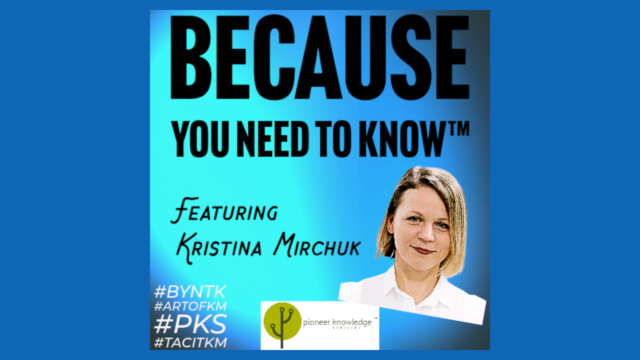
KM in project-based & temporary organisations: Part 3 – The role of the project manager
This article is part 3 in a series of articles on knowledge management (KM) in project-based and temporary organisations.
The first part of this series of articles looked at the barriers to knowledge sharing and transfer in project-based and temporary organisations, and the subsequent parts of the series provide research-based advice on how to overcome these barriers. This part (part 3) focuses on the role of the project manager.
From the research literature, three key topics relevant to the knowledge management (KM) role of the project manager emerge:
- Knowledge management competence.
- Understanding and mapping project knowledge networks.
- Knowledge hiding and hoarding.
1. Knowledge management competence
A paper1 by Raisinghani and colleagues, a group of researchers from Texas Woman’s University and Savannah State University, identifies knowledge management (KM) competence as one of five major issues that the 21st century project manager may experience. The other four issues are globalization and cross-cultural issues, technology, organizational structure, and education and professional development.
Raisinghani and colleagues identify the storage and accumulation of knowledge, content and quality of knowledge, ability to utilize knowledge, and knowledge transfer as just a few of the KM competence issues of importance for the contemporary project manager. They then outline the following approaches that the project manager can use to demonstrate this competence:
- Establishing a common framework and taxonomy for categorizing knowledge and standardized approaches to its management. This helps to prevent disparate approaches and therefore results, as well as enhancing the finding and sharing of knowledge.
- Creating a knowledge management plan that outlines:
- information and knowledge that would help the team deliver the project
- where it can be found
- how it can be accessed
- who will take accountability for finding and using it.
- Transferring knowledge and lessons learned so that project managers learn from each other rather than reinventing knowledge.
- Creating a team culture that facilitates the development of project goals and group norms which support learning and knowledge sharing.
However, while Raisinghani and colleagues identify aspects of the “what” of KM competence for project managers, they don’t explore “how” project managers can gain this competence. This is despite elsewhere in their paper identifying the importance of project management education and certification for project managers. Aligning with project management certification, two programs that could assist project managers in gaining KM competence are the KM Institute’s Certified Knowledge Manager (CKM) and the University of Ottawa Professional Development Institute’s Certificate in Knowledge Management.
As CILIP alerts though, KM competence does not equate to the completion of courses alone. It also needs to involve the acquisition of skills through professional development and experience, and this is reflected in CILIP’s KM Chartership. Professional development needs to include participation in external conferences and workshops, and the internal courses and coaching convened within organizations. As Alqahtani discusses in their University of Salford doctoral dissertation2 referenced in part 2 of this series, facilitating such participation is a function of Project Management Offices (PMOs).
Raisinghani and colleagues advise that professional development for project managers also needs to involve participation in professional organizations. Key professional networks for KM include SIKM Leaders, KM4Dev, and KMGN. A further professional development approach is mentoring, and facilitating mentoring programs for project managers could also be a function of PMOs.
2. Understanding and mapping project knowledge networks
In their conference paper3 referenced in part 1 of this series, Wiewiora and colleagues advise that a project manager is in the centre of a project network. They alert that:
A project network needs constant maintenance, in which the project manager and the project management methodology help to keep the project manager at the centre of the project.
To be able to effectively maintain the project knowledge network, it needs to first be understood. This aligns with Raisinghani and colleagues’ advice in section 1 above in regard to creating a knowledge management plan that outlines information and knowledge that would help the team deliver the project, where it can be found, how it can be accessed, and who will take accountability for finding and using it.
A previous RealKM Magazine article summarises a range of knowledge mapping techniques that can be used to help develop this understanding, with links to further information. From the techniques listed in that article, the ones most relevant to this task are knowledge asset maps and social network analysis. Other listed techniques that could also be useful include topic maps, process knowledge mapping, and information flow analysis.
After an initial understanding of the project knowledge network has been established, the network can be maintained by ensuring that project staff use the network mapping products as part of their day-to-day work, and alert the project manager to any needed updates. For longer projects, the project knowledge network should ideally be re-mapped on a regular basis to ensure its accuracy and relevance.
3. Knowledge hiding and hoarding
Wiewiora and colleagues also advise that project managers often hoard knowledge. This knowledge hoarding can be a serious problem because project managers are located at the centre of a project network, as discussed in section 2 above. Two reasons for the knowledge hoarding were identified in part 1 of this series: a lack of time to effectively share knowledge, and the sharing of “bad news” not being encouraged.
In regard to a lack of time to effectively share knowledge, both Alqahtani and Wiewiora and colleagues alert to the role of PMOs in assisting project managers in the transfer of knowledge and lessons learned, as discussed in part 2 of this series.
In regard to the sharing of “bad news,” Wiewiora and colleagues advise that knowledge hoarding by project managers is a problem in both the public and private sectors. However, they see it is a bigger problem in the public sector environment where “bad news” is often not welcomed and so people tend to hoard information that relates to their faults. This action is actually more appropriately described as knowledge hiding rather than knowledge hoarding.
Both knowledge hiding and knowledge hoarding are defined4 as opposites of knowledge sharing. Knowledge hiding is the intentional concealment of knowledge requested by another individual, whereas knowledge hoarding is defined as the accumulation of knowledge that may or may not be shared at a later date.
While research in regard to addressing knowledge hiding and hoarding is still in its infancy, some useful guidance has already emerged. This guidance should be considered by organizations, PMOs, and project managers themselves. Two previous RealKM Magazine articles summarise this guidance for knowledge hiding and knowledge hoarding, as part of an ongoing series of articles on knowledge withholding, hiding, and hoarding.
Next part (part 4): Agile and rapid and direct lesson learning.
Header image source: Alvaro Reyes on Unsplash.
References:
- Raisinghani, M. S., Arora, A., Folsom, M., Pieri, F., Banas, D., & Fletcher, J. (2019). Contemporary Issues in Project Management: The Twenty-First Century Project Manager’s Perspective. Decision Sciences. ↩
- Alqahtani, A. (2019). An appraisal of the role of Project Management Offices (PMO) in promoting Knowledge Management (KM) within KSA construction companies. University of Salford (United Kingdom). ↩
- Wiewiora, A., Trigunarsyah, B., Murphy, G., & Liang, C. (2009). Barriers to effective knowledge transfer in project-based organisations. In Proceedings of the International Conference on Global Innovation in Construction (pp. 220-230). Loughborough University. ↩
- Bilginoğlu, E. (2019). Knowledge hoarding: A literature review. Management Science Letters, 9(1), 61-72. ↩
Also published on Medium.






